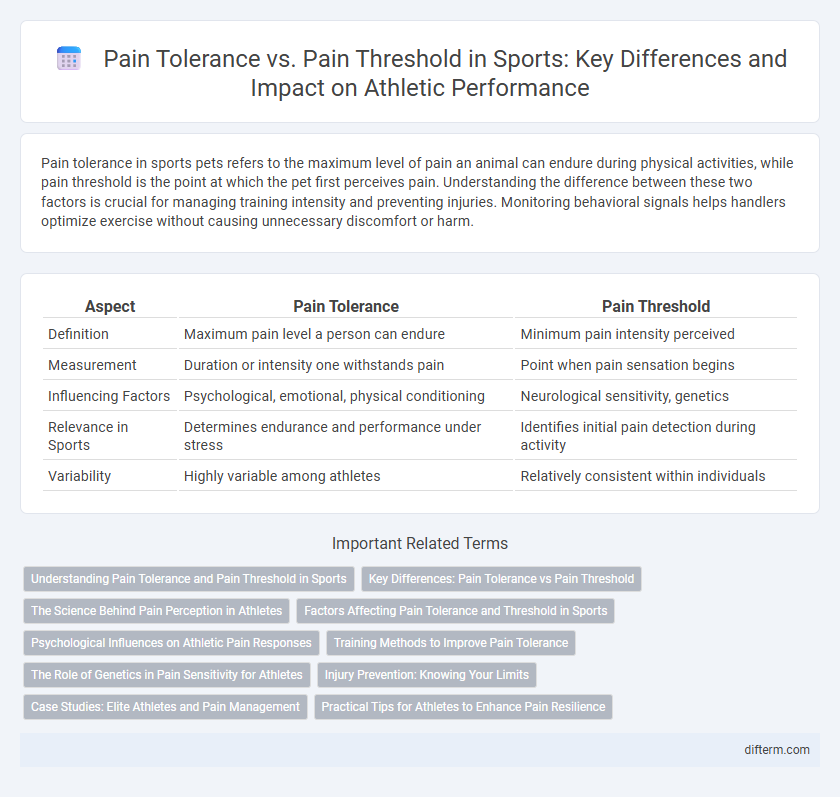Pain tolerance in sports pets refers to the maximum level of pain an animal can endure during physical activities, while pain threshold is the point at which the pet first perceives pain. Understanding the difference between these two factors is crucial for managing training intensity and preventing injuries. Monitoring behavioral signals helps handlers optimize exercise without causing unnecessary discomfort or harm.
Table of Comparison
| Aspect | Pain Tolerance | Pain Threshold |
|---|---|---|
| Definition | Maximum pain level a person can endure | Minimum pain intensity perceived |
| Measurement | Duration or intensity one withstands pain | Point when pain sensation begins |
| Influencing Factors | Psychological, emotional, physical conditioning | Neurological sensitivity, genetics |
| Relevance in Sports | Determines endurance and performance under stress | Identifies initial pain detection during activity |
| Variability | Highly variable among athletes | Relatively consistent within individuals |
Understanding Pain Tolerance and Pain Threshold in Sports
Pain threshold refers to the minimum intensity at which a stimulus is perceived as painful, while pain tolerance indicates the maximum level of pain an athlete can endure during physical activity. In sports science, athletes with higher pain tolerance often perform better under stress, as they can push through discomfort without compromising technique or focus. Training techniques, mental conditioning, and individual physiological factors influence both pain threshold and tolerance, impacting overall athletic performance and recovery.
Key Differences: Pain Tolerance vs Pain Threshold
Pain threshold refers to the minimum intensity at which a stimulus is perceived as painful, while pain tolerance indicates the maximum amount of pain an individual can endure. Athletes with a high pain threshold may not feel discomfort until the pain intensity is substantial, but those with a high pain tolerance can withstand severe pain without quitting. Understanding these distinctions helps optimize training, injury management, and performance in competitive sports.
The Science Behind Pain Perception in Athletes
Pain tolerance and pain threshold represent distinct components of pain perception in athletes, with pain threshold indicating the minimum intensity at which a stimulus is perceived as painful, and pain tolerance defining the maximum pain an athlete can endure. Neurophysiological factors such as endorphin release, pain modulation pathways, and central nervous system adaptability significantly influence these pain parameters, often enhanced through rigorous training and psychological conditioning. Research demonstrates that athletes exhibit altered pain processing through mechanisms like increased activation of descending inhibitory pathways and heightened endogenous opioid activity, contributing to superior pain management and performance under stress.
Factors Affecting Pain Tolerance and Threshold in Sports
Pain tolerance and pain threshold in sports are influenced by genetics, psychological state, and training intensity. Athletes with rigorous conditioning programs often develop higher pain tolerance, enabling prolonged performance under discomfort. Neurochemical variations, such as endorphin release, and mental resilience also significantly modulate individual pain perception during physical activity.
Psychological Influences on Athletic Pain Responses
Psychological influences significantly shape athletes' pain tolerance and pain threshold, impacting performance during high-intensity sports. Factors such as motivation, focus, and stress resilience alter the perception of pain, enabling athletes to endure discomfort beyond physiological limits. Understanding the role of mental conditioning and cognitive strategies enhances pain management, contributing to improved athletic outcomes and injury prevention.
Training Methods to Improve Pain Tolerance
Training methods to improve pain tolerance in sports include high-intensity interval training (HIIT), which conditions athletes to perform under physical stress and discomfort. Gradual exposure to incremental pain stimuli through endurance exercises enhances the body's adaptive response, increasing the ability to withstand pain during competition. Mental techniques such as mindfulness meditation and visualization also play a crucial role in modulating pain perception and boosting overall pain tolerance.
The Role of Genetics in Pain Sensitivity for Athletes
Genetics significantly influence an athlete's pain tolerance and pain threshold by determining variations in nociceptor sensitivity and neurotransmitter function. Specific gene polymorphisms, such as those in the COMT and SCN9A genes, affect how pain signals are processed, impacting endurance and injury recovery. Understanding these genetic factors allows for personalized training and pain management strategies to optimize athletic performance.
Injury Prevention: Knowing Your Limits
Athletes with a high pain tolerance may push through discomfort, increasing the risk of injury by ignoring early warning signs. Understanding the pain threshold--the point at which a stimulus becomes painful--helps identify when to stop and seek rest or treatment, crucial for injury prevention. Monitoring these limits allows for strategic training adjustments that reduce overuse injuries and enhance long-term performance.
Case Studies: Elite Athletes and Pain Management
Case studies involving elite athletes reveal that pain tolerance significantly exceeds their pain threshold, allowing them to perform under conditions that would incapacitate average individuals. Research on marathon runners and professional cyclists shows adaptive psychological and physiological mechanisms, such as endorphin release and cognitive reframing, which enhance pain management during intense competition. These findings emphasize the critical role of mental resilience and tailored pain modulation strategies in optimizing athletic performance and recovery.
Practical Tips for Athletes to Enhance Pain Resilience
Athletes can improve pain resilience by gradually exposing themselves to controlled discomfort through techniques like progressive overload and cold water immersion, which help increase pain tolerance and raise the pain threshold. Incorporating mindfulness meditation and breathing exercises aids in modulating the nervous system's response to pain signals, enhancing overall endurance during intense training or competition. Consistent recovery practices, including adequate sleep and nutrition, support the body's ability to repair tissues, reducing pain sensitivity and improving long-term performance outcomes.
pain tolerance vs pain threshold Infographic

 difterm.com
difterm.com